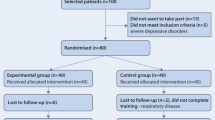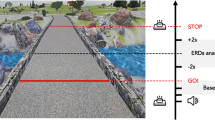Abstract
Background and aims: Several studies have demonstrated the effectiveness of mental imagery in improving motor performance. However, no research has studied the effectiveness of such a technique on static balance in the elderly. This study evaluated the efficiency of a mental imagery technique, aimed at improving static balance by reducing postural oscillations and attentional demands in the elderly. Methods: Twenty subjects aged 65 to 90 years old, divided into two groups (8 in Control group and 12 in Experimental group) participated in the study. The experimental participants underwent daily mental imagery training for a period of six weeks. Antero-posterior and lateral oscillations, reaction times during the use of the double-task paradigm were measured, and the Berg Balance Scale, Activities-specific Balance Confidence Scale, and VMIQ questionnaire were answered during both pre-test and post-test. Results: Attentional demands and postural oscillations (antero-posterior) decreased significantly in the group with mental imagery training compared with those of the Control group. Subjects in the mental imagery group became significantly better in their aptitudes to generate clear vivid mental images, as indicated by the VMIQ questionnaire, whereas no significant difference was observed for the Activities-specific Balance Confidence Scale or Berg Scale. Conclusion: The results support psychoneuromuscular and motor coding theories associated with mental imagery.
Similar content being viewed by others
References
Kannus P, Niittymaki S. Which factors predict outcome in the non-operative treatment of patellofemoral pain syndrome? A prospective follow-up study. Med Sci Sports Exerc 1994; 26: 289–96.
Nevitt M, Cummings C, Steven R. Type of fall and risk of hip and wrist fractures: The study of osteoporotic fractures. J Am Geriatr Soc 1993; 41: 1226–34.
Shumway-Cook A, Anion D, Haller S. Postural sway biofeedback: its effect on re-establishing stance stability in hemiplegic patients. Arch Phys Med Rehabil 1988; 69: 395–400.
Alexander NB. Postural control in older adults. J Am Geriatr Soc 1994; 42: 93–108.
Era P, Heikkinen E. Postural sway during standing and unexpected disturbance of balance in random samples of men of different ages. J Gerontol 1985; 40: 287–95.
Hay L. Static and dynamic posture control in the elderly. In Fernandez AM, Teasdale N, eds. Advances in psychology (114) Changes in sensory motor behavior in aging. Amsterdam North-Holland: Elsevier, 1996: 134–55.
Teasdale N, Stelmach GE, Breunig A. Postural sway characteristics of the elderly under normal and altered visual and support surface conditions. J Gerontol 1991; 46: B238–44.
Lajoie Y, Teasdale N, Bard C, Fleury M. Attentional demands for walking: Age-related changes. In Fernandez AM, Teasdale N, eds. Advances in psychology (114) Changes in sensory motor behavior in aging. Amsterdam, North-Holland: Elsevier, 1996: 235–56.
Welford AT. Reaction time, speed of performance and age. Ann NY Acad Sci USA 1988; 515: 1–17.
Plude DJ, Doussard-Roosevelt JA. Aging and attention: Selectivity, capacity and arousal. In Lovelace EA, ed. Advances in psychology (72) Aging and cognition: mental process, self awareness and interventions. Amsterdam, North-Holland: Elsevier, 1990, 97–133.
Kahneman D. Attention and effort. Englewood Cliffs, NJ: Prentice Hall, 1973.
Girouard Y. L’attention et l’acquisition de l’habileté motrice. In Nadeau CH, Halliwell WR, Newell KM, Roberts GC, eds. Psychology of motor behavior and sport. New York: Human Kinetics publishers, 1980: 535–52.
Decety J, Ingvar DH. Brain structures participating in mental simulation of motor behavior: a neuropsychological interpretation. Acta Psychol 1990; 73: 13–34.
Feltz DL, Landers DM. The effects of mental practice on motor skill learning and performance: a meta-analysis. Journal of Sports Psychology 1983; 5: 25–57.
Swets JA, Bjork RA. Enhancing human performance: an evaluation of “new age” techniques considered by the U.S. Army. Psychol Sci 1990; 1: 85–95.
Denis M, Chevalier N, Eloi S. Imagerie et répétition mentale dans l’acquisition d’habiletés motrices. In Morin G, ed. Tâches, traitement de l’information et comportements dans les activités physiques et sportives. Boucherville, QC, 1989, 11–37.
Deschaumes-Molinaro C, Dittmar A, Vernet-Maury E. Relationship between mental imagery and sporting performance. Behav Brain Res 1991; 45: 29–36.
Lang PJ. A bio-informational theory of emotional imagery. Psychophysiology 1979; 16: 495–512.
Murphy SM, Jowdy DP. Imagery and mental rehearsal. Advances in Sports Psychology 1992; 12: 221–50.
Jeannerod M. The representing brain: neural correlates of motor intention and imagery. Behav Brain Sci 1994; 17: 187–245.
Isaac A, Marks DF, Russell DG. An instrument for assessing imagery of movement: the vividness of movement imagery Questionnaire (VMIQ). Journal of Mental Imagery 1986; 10: 23–30.
Berg KO, Wood-Dauphinee SL, Williams JI, Maki BE. Meausuring balance in the elderly: validation of an instrument. Can J Public Health Suppl 1992; 83: S7–11.
Powell LE, Myers AM. The activities-specific balance confidence (ABC) scale. J Gerontol 1995; 50A: M28–34.
Porter K, Foster J. The mental athlete. Iowa: W.M.C. Brown Publishers Dubuque, 1986.
Lehrer PM. How to relax and how not to relax: a re-evaluation of the work of Edmund Jacobson. Behav Res Ther 1982; 20: 417–28.
Crilly RG, Willems DA, Trenholm KJ, Hayes KC, Delaquerriere-Richardson LF. Effect of exercise on postural sway in the elderly. Gerontology 1989; 35: 137–43.
Pierson WR, Montoye HJ. Movement time, reaction time, and age. J Gerontol 1958; 13: 418–21.
Clarkson PM. The effect of age and activity level on simple and choice fractionated response time. Eur J Appl Physiol 1978; 40: 17–25.
Loveless NE. Aging effects in simple reaction time and voluntary movement paradigms. Prog Brain Res 1980; 54: 547–51.
Gottsdanker R. Age and simple reaction time. J Gerontol 1982; 37: 342–8.
Stelmach GE, Worringham CJ. The preparation and production of isometric force in Parkinson’s disease. Neuropsychologica 1988; 26: 93–103.
Lord SR, Rogers MW, Howland A, Fitzpatrick R. Lateral stability, sensorimotor function and falls in older people. J Am Geriatr Soc 1999; 47: 1077–81.
Shumway-Cook A, Baldwin M, Polissar NL, Gruber W. Predicting the probability for falls in community-dwelling older adults. Phys Ther 1997; 77: 812–9.
Author information
Authors and Affiliations
Corresponding author
Rights and permissions
About this article
Cite this article
Hamel, M.F., Lajoie, Y. Mental Imagery. Effects on static balance and attentional demands of the elderly. Aging Clin Exp Res 17, 223–228 (2005). https://doi.org/10.1007/BF03324601
Received:
Accepted:
Published:
Issue Date:
DOI: https://doi.org/10.1007/BF03324601




